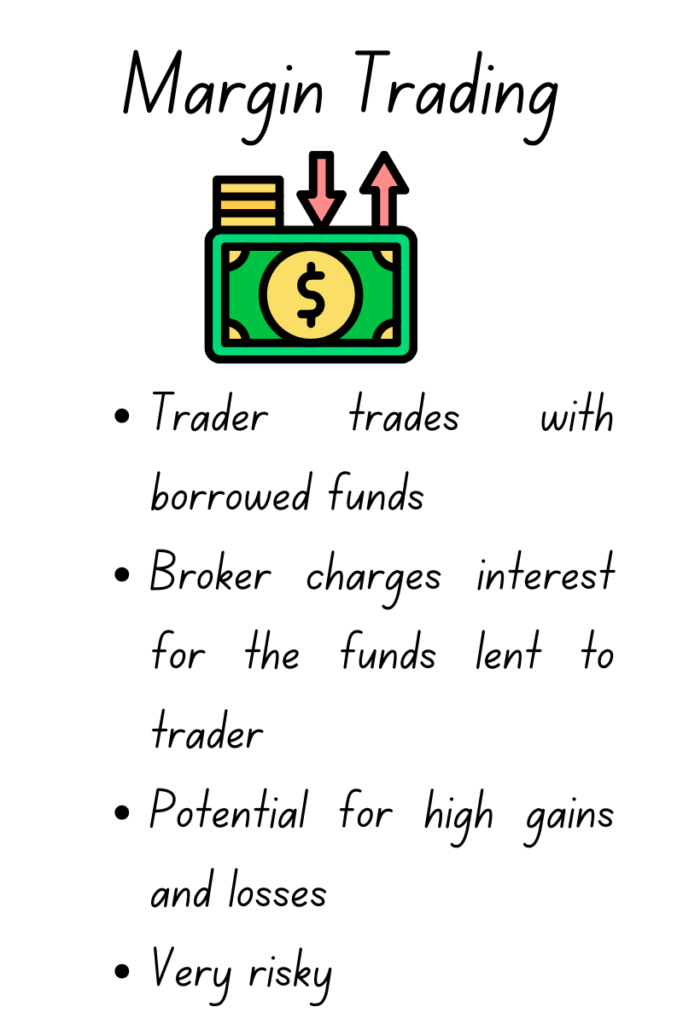When an investor trades shares, financial instruments with money borrowed from the broker, the investor has to maintain or deposit a certain amount as ‘security’ or ‘collateral’ with the broker. This is done to cover the credit risk which the broker takes while lending the money to the investor. This amount which is kept as a collateral with the broker is called margin money. Margin money has to be kept whenever an investor does any form of trading using borrowed funds from the broker.
Table of Contents
Types of margin
- Initial margin – refers to the minimum amount that a trader needs to keep in his/her Demat account while trading in futures.
- Maintenance margin – refers to the minimum amount that a trader has to maintain in his/her account in order to continue holding an open position in the market at all points of time.
- Mark to market – refers to the cash margin which the trader pays to bring the open position at the day’s closing market value. This is also called daily settlement of open positions.
- Variation margin – refers to the additional/incremental margin to be added to the trading account when a margin call is received.

Examples of margin
Let us understand all the above margin types with an example. Dev is a trader and has a trading and demat account. He purchases 1 lot of futures of ‘John Black Ltd’ at Rs 2,000. The lot size of ‘John Black Ltd’ is 100. So the total contract value is Rs 200,000 [2000*100]. To buy the future lot Dev, needs to keep cash balance of 15% of the contract value in his trading account. He needs to keep Rs 30,000 [200,000 *15%] as cash balance. This amount is initial margin. So Dev has to shell out only Rs 30,000 of his own funds to buy futures lot with contract value of Rs 200,000.
Dev continues to hold his futures position. The next day futures lot of ‘John Black Ltd’ closes at Rs 1,800. The maintenance margin for this scrip is 10% of contract value. This means 10% of the contract value should be retained as margin at any given point in time. The contract value of the contract was Rs 200,000 and 10% would be Rs 20,000. As at close of the trading day, Dev has incurred a loss on his futures position of Rs 20,000 [(2000-1800)*100]. His initial margin of Rs 30,000 would be offset with this loss. So now Dev, will have to deposit additional Rs 10,000 in his trading account as maintenance margin to comply with the 10% requirement. A margin call will be made by the broker.
On day three, the futures lot of ‘John Black Ltd’ closes at Rs 2,050. Dev makes a profit of Rs 5,000 [(2050-2000)*100] on his futures position. This profit will be credited to his account i.e. the funds will be deposited in his trading account. This is called mark to market wherein daily profit or loss is settled on an open position.
On day four, Dev short sells 1 lot of futures of ‘Red White Ltd’ which are trading at Rs 900 and the lot size is 50. The futures close at Rs 850 on day four. Dev has made a profit of Rs 2,500 [(900-850)*50]. This amount will get credited to Dev’s trading account.
On day five, the futures price of ‘Red White Ltd’ increases and closes at Rs 1000. Here Dev makes a loss of Rs 5,000 [(1000-900)*50]. This amount will be debited to his trading account.
What is a margin call?
A margin call is when a broker requires an investor to contribute additional funds to meet the minimum margin amount requirement. The call is made when the trading positions lose money or additional trading positions are taken which drive the equity balance to fall below the required minimum to hold these positions. If the margin call is not met, the broker can sell the securities in the account.
How does margin trading work?
- The trader opens a margin trading facility (MTF) account with the broker. MTF account is a type of a brokerage account where the authorized broker will disburse funds to an investor to purchase stocks or other such financial products.
- The trader has to deposit the initial margin when he/she starts a trade. The remainder amount of the trade is loaned by the broker.
- The broker charges interest on the loan amount as long as the loan remains outstanding. This increases the traders cost as the trader has to provide funds as margin and also pay interest on the loan portion.
- The margin is settled once the trader squares off the position in the stock market.
Advantages & Disadvantages of margin trading
| Advantages | Disadvantages |
| Increased purchasing power | Increased costs in the form of fees and interest charges |
| Potential for greater gains due to leverage. | Potential for higher losses due to leverage. |
| Has more flexibility than other type of loans | May result in margin calls which lead to additional funds investment |
Margin trading is a very risky activity as traders trade with borrowed funds. Those who indulge in margin trading should ensure they don’t borrow the maximum amount. They should also maintain adequate cash and liquid funds to meet the margin requirements. In India, margin trading is regulated by SEBI.
One needs to remember and understand that even if profits are earned in margin trading it is being earned using borrowed funds. The profits will make sense only when they exceed the sum total of margin money and loan interest cost. Also the trader needs to have the equivalent amount of funds borrowed, either in liquid funds or cash, as the loan will have to be paid back to the broker irrespective of whether the trader makes profits or losses.
Image credit: Image by freepik



